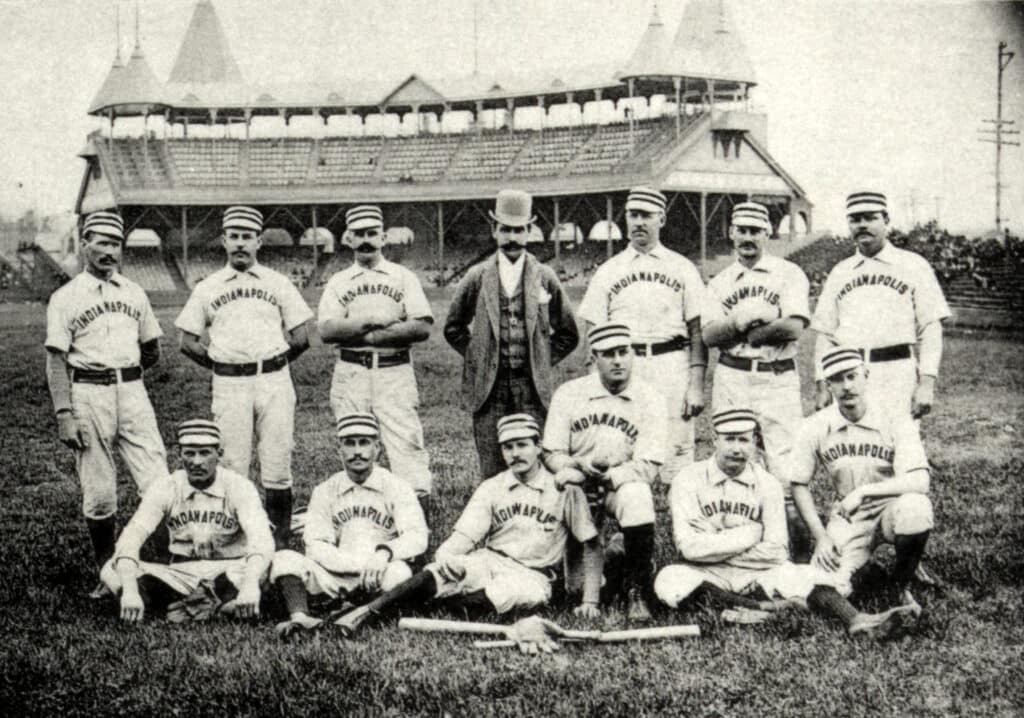Baseball in Noblesville and Hamilton County: Catching Thunderbolts
By: David Heighway, Hamilton County Historian
Continuing the discussion of Noblesville’s “Boys of Summer”, I decided to take a look at Michael Patrick “Nick” Ivory, a professional baseball player who played with some legendary Hall of Famers before eventually settling in Noblesville. He was born in Covington, Kentucky, February 4, 1868 to Irish immigrants John and Sarah Ivory. His father died in 1878 and by 1880, his mother & older sister were laundresses, his other older sister was a seamstress, his brother worked in a glass factory, and he went to school with his three younger sisters.
He said in a later interview that the first team that he played for was a Logansport, Indiana, team known as the “Ottos”. He then played for a team in Mansfield, Ohio in 1888. He was the catcher, a position he would hold the rest of this life, and was going by the name of Nick. He apparently preferred this name as his birth name rarely appears in any document. He would often formalize it to “Nicholas P.” or “Nicholas T.”
He was with the Goshen, Indiana, team in 1889, when he met the pitcher Bert Inks. Their teamwork was very successful, and, because of their names, they became known as the “Black and White Battery”. They were good enough that they received an offer from the Washington Senators ball club.
The pair apparently got a better offer from the Indianapolis Hoosiers. This gave Ivory an opportunity to work with Amos Rusie, the “Hoosier Thunderbolt”. Rusie was one of Indiana’s most famous players and was responsible for a change in the design of the baseball diamond. As a pitcher, he threw the ball so hard and so fast that the distance between the pitcher’s mound and the home plate had to be increased. Since Ivory was a catcher, this would have been quite a challenge. Unfortunately, they never had a chance to play in a game together. Ivory and Inks were signed to the team in January of 1890 and the club folded in March.
 Ivory was supposedly to go play for the Cleveland team, but ended up in Grand Rapids, Michigan. Then he bounced from Muncie to Fort Wayne and to Galesburg, living with his family in Covington between teams. He was signed to Peru in June of 1891, but this ended – possibly after he and a prizefighter were caught with couple of prostitutes in September.
Ivory was supposedly to go play for the Cleveland team, but ended up in Grand Rapids, Michigan. Then he bounced from Muncie to Fort Wayne and to Galesburg, living with his family in Covington between teams. He was signed to Peru in June of 1891, but this ended – possibly after he and a prizefighter were caught with couple of prostitutes in September.
He was signed to the Western Baseball League in February 1892, recommended by Amos Rusie, and went to Omaha in March. However, he returned on April 13 by hitching a ride on freight train because, as an article said, he was “not swift enough for the Oma’s”. He married his first wife, Maggie Tuttle, on April 30 in Peru. Curiously, an article appeared in a Chicago paper on May 12 saying that Omaha would have a second catcher in place of Ivory who “disappeared”.
In 1895, he played in Wisconsin, and then went to Michigan, supposedly to play for Detroit. Instead he signed for Battle Creek in April and was released in August. He returned to Indiana and played for Anderson and Fort Wayne. In 1896, he became manager of the Anderson team, which was calling itself the “Eagles” or the “Whens”. There are a few stories of him being an umpire in 1899. He finally retired for good from the game in 1900
He became a molder in various factories and foundries, making molds for casting ironwork. He was living in Logansport between 1907 and 1911 and then came to Hamilton County, where he married his second wife, Cora Hill Tochterman, on June 21, 1913. It was a second marriage for her as well. He was working in Noblesville in 1916 and was among those injured in interurban wreck in Tipton in October of 1917. Since the car was northbound to Kokomo, he may have been commuting. Between 1918 and 1929, he and his wife and his son appear in both the Noblesville city directories and Kokomo City directories. The only solid bit of information is that Ivory and his wife are listed in the 1920 census living in a Kokomo boarding house.
He and his wife had purchased a house on Cherry Street in Noblesville by 1930. Soon after this, he had an opportunity for a last gesture towards his old career. May 25, 1932, was Old Timer’s Day at Perry Field (later Victory Field and Bush Stadium) in Indianapolis. Many of the old ballplayers were there. One of the other attendees was Bert Inks, who had given up baseball because of health issues not long after he and Ivory had gone their separate ways.
Ivory was interviewed a year later (Ledger, May 8, 1933, p.6) and reminisced about his years in baseball. He told one humorous anecdote about holding a record for a batter getting a strike and missing a ball by the longest distance. He had mistakenly swung when a pitcher turned and threw the ball to tag a runner on first base, thereby missing the ball by ninety feet. Ivory died in October of 1949 and is buried at Crownland Cemetery. His headstone is marked “Nick Ivory”.
